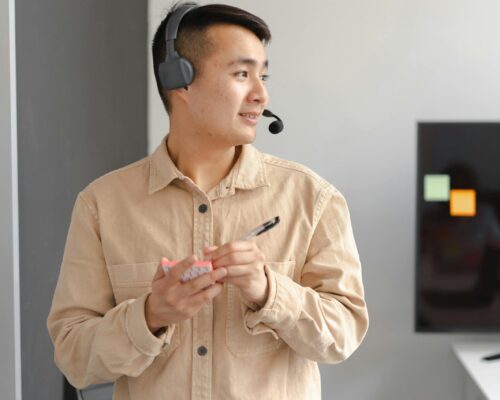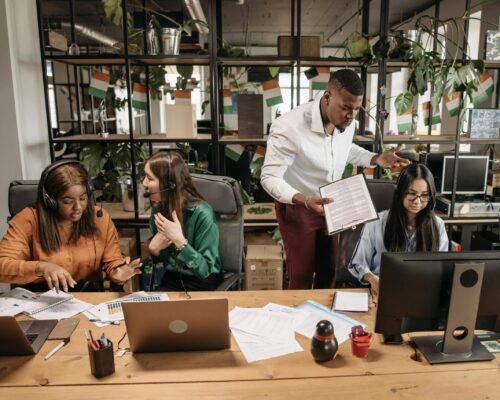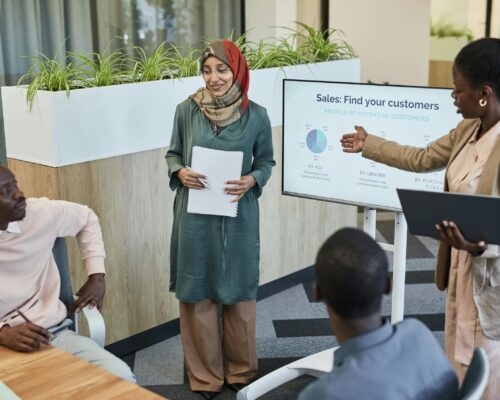Hideki Hashimura, CRM strategist and CMO at redk; Tom Jeanes, UK Commercial Lead at redk; and George Cox, Project Lead at redk recently participated in a redk webinar on intelligent automation and conversational messaging.
Thanks to their extensive experience in the field, the speakers were able to offer insights on the future of intelligent automation and conversational messaging.
The webinar also featured Will Fisher, UK Sales Director, and Inayat Shariff, Principal Solution Consultant, from our redk partners at Laiye to discuss their automation platform designed to bridge the gap between digital and human. Hideki discussed the current trends laid out by Forrester in depth; Tom and George dove into a detailed description of redk’s work with Baleària; and the Laiye team showcased their Work Execution System (WES) platform.
We here at redk have summarised the highlights of the webinar. Discover how we’ve already kicked off the future of intelligent automation and conversational messaging.
Now trending: A spotlight on Forrester’s CX trends
Forrester is a leading global market research and advising company. Their insights help us here at redk find the best strategies for organisations to implement, all while keeping us updated on the latest trends.
During this section of the webinar, our redk CMO, Hideki Hashimura, broke down the most important trends from Forrester’s travel and hospitality research, including how to be future fit and the importance of tech for resilience and growth.
In the post-pandemic environment, CIOs are in the spotlight and are feeling more pressure to redesign the way they operate and deliver services. Future fit tech companies grew 1.8 times faster than their peers. In fact, in 2023, tech executives will pivot to pragmatic, innovation-focused solutions to improve operational resilience, with 80% of companies shifting efforts away from creativity.
This shift is impacting the customer experience. Conversational messaging is the channel used to materialise the value of intelligent automation into practical ways as a way to not only shift but also improve CX. This is causing companies to migrate from a very simple use of live chat to ways to automate customer service as much as possible.
The important thing is that this migration is driven by customer needs. And as not all customers are the same, touchpoint references and channel usage must be split into three categories:
- Self-service: one of the most-common ways for a customer to interact with a brand
- Automated: customers expect help buying or using a service
- Person-to-person: one person per customer. This is where we need to scale up and automate.
It comes down to customers wanting guidance when navigating their options, but only on their terms. In the UK, 32% of respondents expect to be able to interact with a brand in some form of virtual assistant.
Chatbots come with a bit of a negative image, but research shows that 60-70% of customers have used assistants that have impacted their ability to buy products or services. In travel and hospitality, for example, the processes can be cumbersome and chatbots can complete the tedious tasks, allowing customers to get more value.
Companies must strategise in order to create an experience that also helps business growth. This can be done with three elements from a customer perspective in mind:
- Desirability to customers
- Feasibility to create at scale
- Visibility for the business
And at the centre of these elements, there needs to be a goal – and that goal is pleasing the customer.
Travel is the type of sector where you’re helping a lot of people in a small time. So scaling up functionality is very important. It’s also imperative to be future fit, which Forrester discusses frequently. ‘A customer-obsessed approach to technology that enables a company to quickly reconfigure business structures and capabilities to meet future customer and employee needs with adaptivity, creativity, and resilience.’
Overall, this is done through the core drivers like intelligent automation, best practices, and the partners that enable this. Being future fit is placing a strong focus on the customer and the employee. Intelligent automation is about maximising human potential. This is what is going to create a competitive advantage for organisations in the sector.
Baleària: Building automated and personalised content
Baleària is the leading shipping company in the Mediterranean – and also the largest in the region, with a fleet of 33 ships, serving a total of three continents. Their business model has many different layers: B2B, B2C, and so on. This means they have a lot of different customers with unique needs, and they must interact with all of them in personalised ways. Baleària has over 1,800 employees, plus seasonal staff. Most of their customer experience team joins for the high season in the summer, so they frequently have to onboard a large number of staff in very little time.
For Baleària´s customers, price is fundamental, but so is the customer experience. The expectations of customers, agents, and organisations are in constant evolution, so it is – and will continue to be – a very challenging market.
We here at redk stepped in to help them tackle the challenges of a shifting market. We started at a high level to understand their organisational goals, then worked one by one through their specific objectives and implemented technology to ease specific pain points.
One specific step was to integrate their multi-platform reservation management platform into an intelligent, omnichannel communication system with software from our partners at Zendesk. By unifying communication and reservation management, Baleària could finally offer a smooth, fast customer experience across multiple channels.
Now, the same customer can contact Baleària by Whatsapp, web chat, email or phone. With Zendesk technology, all those contacts will be registered into one unified customer profile. Baleària staff will have a 360-degree view of their customer’s situation, meaning they can offer the best possible customer experience.
Automated conversation tools free up customer agents from the most routine questions. Users become more proactive when they are offered an up-to-date help centre, knowledge base, and integrated communication channels. Bots can help them find their own answers by pulling information from any of these systems and platforms. Allowing self-service tools to take the brunt of quick wins not only means the customers get their answers much faster, but it’s also easier to onboard new staff. The tool itself is a teacher, showing them from within what best practices look like.
Throughout this section of the webinar, we saw the value that efficient workflows bring to a company and gained a clearer understanding of how Zendesk adds that unified customer view to Baleària. By empowering employees with knowledge and guiding them through all stages of the workflow, your organisation too can build a consistent customer experience by improving inefficiencies and driving faster sales cycles.
Laiye: A new platform designed for future-fit organisations
As the webinar continued, representatives from our partners at Laiye technology showcased their new Work Execution System (WES) platform. Explaining its capabilities and offering a demonstration of the way in which the model learns, Laiye proved to us here at redk that they are on the right path towards being future fit. The team noted that the challenge to solve is present today, especially as work has changed irrevocably and it will never be the same again.
Disruption, supply change issues, demographic change, attitudinal change and radically accelerated norms like remote working and employee demand create a challenging environment for employees and employers alike. Laiye recognises that gap and aims to fill it.
To identify what has changed, Laiye interviewed 1,300 respondents. According to their research, the biggest issues employers face is attracting the right skills (74%); half are tired of doing repetitive tasks; and 27% are increasingly more negative, which in turn, deteriorates productivity. The great resignation is not over and quiet quitting is having an impact on businesses including reduced productivity, slower company growth, and loss of revenue.
The work execution gap is between what work is and what it should and could be. It’s two-folded, featuring both human and digital elements. It’s hard to leverage tech but also difficult to track KPIs and find updated knowledge in both seasoned and newer employees.
Automation alone cannot close the gap. It’s its own tool, adding to integration costs. Automation software was built before the artificial intelligence boom, so it is not up to par – companies need more. At Laiye, the solution is the WES platform, which closes the gap between the human and digital worker.
With a WES, organisations can automate any type of process due to the must-have features: it must be able to work and leverage the meta-data and it must be worker enabled so that employees can understand it and utilise it to its fullest. WES is an easy-to-use, single platform that is AI native.
Laiye is about integration, not replacement. And the proof is in the data – every year Laiye’s customers automate 180 million conversations, 60 million hours of repetitive software operations, and 110 million pages of documents.
The technology within the WES includes:
- RPA (robotic process automation): to automate mundane tasks and connect legacy systems without requiring developer skills
- IDP (intelligent document processes): to tackle unstructured data and extract data points with out-of-the-box implementation
- Chatbot: real-time communications and can be integrated anywhere
Laiye’s platform has reached success with leading travel companies such as Avanti West Coast, automating 85% of conversations, and Wizz Air, with chatbots automating 92% of their messages.
In their aim to be future fit, Laiye follows the idea that their platform must be for ‘any work, any system, any data, any employee.’ The webinar continued with examples of how the platform learns, further showcasing that Laiye’s technology can be utilised to automate various processes.
Intelligent automation FAQs with Laiye
When thinking about implementing technology, it is natural to have a question. Our redk team gathered a list of frequently asked questions and fired them off to our partners at Laiye. We’ve comprised the highlights of the rapid-fire Q&A section of the webinar.
How easy is it for your customers to get the most out of this tool?
A few years ago, everything that needed to be implemented required highly technical resources to manage implementation. With each of Laiye’s solutions, the interfaces allow non-technical employees to connect and use the solutions easily. There are still some aspects that require RPA developers, but that requirement is lessening, allowing more team members to be involved in the process.
How soon can we expect to see value from the platform?
Laiye has shortened the time necessary to see value, meaning companies will see value within the first phase of implementation. The first phase will target high volume and relevant inquiries, quickly and rapidly managing tedious tasks. The more complex inquiries can progress naturally as time goes on.
Could you give more background on how Laiye compares to other providers?
Chatbot companies seem to offer similar solutions, and in the past, we’ve worked with bad chatbots as the technology and language learning wasn’t good enough. Chatbots and tech have since improved across the board. But the real differentiation is the ability to automate more processes using our WES platform off the shelf. We’ve combined our chatbots, RPA, and IDP capabilities, offering one, integrated platform. With Laiye, it’s easier to give customers value sooner rather than later – our combination is really a game changer.
At redk, we pride ourselves on over 15 years’ experience as CRM experts. Our goal is to help your organisation streamline processes and integrate the best tools on the market to achieve lasting customer service excellence. Reach out for more information today.










